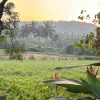Goa is abuzz with excitement as vintage bike and car owners, users, collectors and fans are decking […]

MY GOA, YOUR GOA, OUTSIDER’S GOA…
Apr 27- May 03 2024, BOOK REVIEW April 26, 2024`Becoming Goan, A contemporary coming-home story’ by Michelle Mendonca Bambawale, an imprint of Penguin Random House, paperback, Rs399
IF you’re crazy about Goa and want to come and retire and live here and are a connoisseur of all things Goan…here’s a book to read. A small but interesting colonial state like Goa has several books cluing up Goans and non-Goans about Goa’s history from times immemorial to today’s turbulent (traumatic?) changing times. You want to catch up with some special life and times of Goa here’s one more book — Michelle Mendonca Bambawale’s `Becoming Goan, A contemporary coming-home story.’
Home is as much places from the past as places we come to terms today because we want to drink good water, breathe good air and eat good food, not to forget live a life worth living for and as it happens in Goa if you’re lucky, some family member leaves you an old so-called Portuguese vintage time house! Then naturally you visit Goa, recollect old memories and fall in love all over again with the state and want to return to your ancestral “home” – as if in a bid to run away from the rest of the world, thinking, aaah, home at last, Goa.
Home is a dilemma for many in Goa and today’s ground realities may disillusion many a Goan trying to re-discover the Goa of old! Amongst them are those who fled from colonial oppression, those who converted and stayed, or those who didn’t but lived quietly making the best of history’s paisa feko tamasha dekho events as they unfurled. Here’s a book – “Becoming Goa” by Michelle Mendonca Bambawale — which sums up very well the contemporary dilemmas which plague those who seek to return to their homeland courtesy their grandparents or parents legacy.
Michelle Mendonca Bambawale is of Goan parentage although born and bred in Pune. She inherits an ancestral house in Siolim in Goa and seeks return to “becoming Goan.” Whatever that means she tells us in this chatty, rationale, full of insight non-fictional account of what it took for her modern-day family to seek peace, homecoming and thanksgiving when she inherited a 160-year-old house…and was torn between pulling out roots elsewhere and growing them anew where her native Goan Catholic family hailed from once upon a time.
Cut to today’s Goa post-Liberation, post-Statehood, post-Opinion Poll and so much more that is quintessential Goan or niz Goankar as is said. In a state where it is hard not to be labeled as a “baile” or outsider even if you claim Goan genes from your father’s or mother’s or parents’s side, this is an insightful and interesting read. How difficult it is to come to terms with a Goa which is slowly ceasing to be what it once was in childhood memories of summer vacations in Goa!
Ah, those days are gone, something like that. And look what’s here and so new to like or dislike…it’s one of your typical Goan stories of scattered Goans or the Goan diaspora scattered across the world seeking to return to roots in their grandparents’ or parents’ homeland from which they once ran away or migrated for the usual reasons: religious colonial oppression, impoverishment, just in search of better opportunities and livelihood. Goa’s history through the ages is fascinating and anyone interested in really understanding today’s Goa would gain a lot if they’re making up their mind about whether they want to come and settle in Goa – the old is giving way to the new which may not be quite palatable and then again, why not?
Find your answers here in the efforts of one family of mixed roots seeking to become Goan for whatever reasons real or unreal! It’s a very sensibly written narrative offering piquant insights into the history of Goa past, post-Liberation and to this day when so much has happened to the country’s smallest (highest per capita income despite the lack of some primary infrastructure) state which is still coming to terms with throwing off old yokes for a new evolving Goa good, bad or ugly.
Traditional agriculturally-rooted green Goa is giving way to more concretization and vertical urbanization with many Goans wondering where the Goa of old still exists here and there and they want a piece of that paradise naturally in Goa! All this is reflected in this book of contemporary perceptions from a born-again Goan or so to speak.
Michelle Mendonca Bambawale’s “Becoming Goan” offers one a kaleidoscopic introduction to Goa past and present, weaving a tapestry of history encompassing tribal, Hindu, Catholic and the many modern and ultra-modern lifestyles which so many seek to live in Goa on a daily basis, or seasonal basis, as they come and go from a much-loved Goa!
You may want to be a Goan or not but if you’re doing Goa in any way this is an impeccable, oftentimes hilarious narrative, encompassing history, culture past and present, religious marginalization, transformations and much more. Everything that which makes Goa the enviable cosmopolitan potpourri of the good life state of India — which everyone loves to love, a place to let down their hair, etcetera. If this vital identity dies, Goa as we knew it or know it, will also die. To be replaced with a Goa …we may only imagine in our worst nightmares!
Excerpted from `Becoming Goan, A Contemporary Coming-home Story” by Michelle Mendonca Bambawala….
The Many Siolims and Goa’s Today
On a September 2021 Sunday morning, trying hard not to let my latest linen loungewear look too crumpled from my breezy drive over, I walked into an Assagao brunch. I’m stopped at the imposing entrance by a sweating security guard, Sorry bhaiya, where can I park?’ He looks surprised to see a disheveled me. Disentangling my cream kaftan and knotted, unruly salt-and-pepper hair, I approach the entrance. The door swings wide and Laxmi has a big welcoming smile.Namaste madamji, Kaise ho: Bahoot dino baad (How are you? Been so long)’. Been travelling. Missed you too. How’s Neena?’Sab theek hai, aapke intezar mein baithi hai (All good, she’s waiting for you).’ I rush through the familiar coiffured garden, up the sweeping staircase and into the modern balcao. Go flying into Neena’s arms, air-kissing, Finally! What will you drink? Bahadur can fix your favorite feni cocktail.’ I accept the sweating drink, umbrella et al. And sink into a lounger, overlooking the inviting infinity pool. I nod away watching birds, guests and babies jump in and out.
Reclining there, semi-comatose, I think of Aunty Lourdes, a few doors down. I had to shout, scream, bang and do a little dance before she could hear and slowly amble up her imposing balustrade to open the barricaded gate tied with blue nylon rope. I admired her bright yellow croton hedge and her pink mussanda in full bloom, while she wrested with the rust.How are you, my girl? Thanks so much for dropping in to see me. So lonely here, no? All alone in this old house, can’t go anywhere with this Covid. Anna and Chris won’t let me. They are both out – one in Canada, one in New Zealand. Anna calls me every day on this WhatsApp so I can see her babas. Things are so bad for her now in Canada, both her babas at home, plus she has to do her office work and her housework. What to do? Can’t help. Big house she has there you know, basement with that big Smart TV something. Deck and lawn and all. She only mows the lawn. Her husband Victor has no time. He works in a restaurant so has those shifts. Never home. You know restaurants are working, delivering food even with this Covid business. How are you managing living in our Goan village my girl? So hard must be for you after living in London and all?’
I hold on to her as we lumber down the many stairs to her crumbling old home with a wrap-around balcao. I remember the deep well at the back of the house and memories of that huge, comforting tamarind tree flood back. Chuckling to myself about the summer spent sitting in the shade sharing secret crushes with cousins, I hope that old trees don’t have ears or memories.
I watch Aunty Lourdes open the imposing front door in her flowery green housecoat. And then in her dark kitchen struggling to find the lighter for the gas, she shuffles over to a fridge, also well past its prime, for some milk. Aunty Lourdes then stoops into the antique meat safe and scrounges around for some Marie biscuits to go with the tea. She lays them out for me on a stained melamine plate on top of her now yellowing, crochet table cloth that covers her antique, wooden and ornate kitchen table.
As I accept the milky-sweet chai and biscuits, I smile to myself about my chat with Ravi, who I ran into on the way over to Aunty Lourdes. I had stopped at the popular French bakery for my fix of their mouth-watering almond croissants — felt guilt-ridden but every bite of the 20,000 calories was worth it. Tying up his man bun and wiping sweat into his vest, Ravi asked, You’re Kunal’s mom, right? I see you here every Sunday. Live round?’Not far, in Siolim.’ Hey Siolim, that’s cool, man. I live in Kensington Gardens. You know where it is?’ I spot the tattoo on his forearm – thinkinganother Japanese character’. Awesome yaar, overlooking this huge paddy. Loving this monsoon man. Such heavy rain. So many cool places here dude. I’ve also seen you over at Uddo, drinking beer, taking in the sunset.’ I flinch, caught red-handed, again, another guilty pleasure. He doesn’t notice:I’m never going back to Bengaluru, bro. All my friends have moved here. I love Goa! It is all just amazing here.’
As I leave the French café, I wave at Andrea, who I recognize from my yoga class, sitting at her regular table. One hand holding her coffee cup, the other smoothening down her straw blond hair. Hey Andrea, what happened to your motorbike, riding a scooter these days?’ She rolls her eyes and shrugs. Andrea stops for coffee and a breather between feeding stray cats and dogs and her Sunday Ashtanga class. I wonder if I should go back now that the classes are face-to-face again.
I say hi to Firoza, who I know from her small cotton clothing store and café, as I walk out. She pours her heart out:So tough managing my restaurant and shop. Things are getting so expensive. People form Delhi buying up everywhere. We came to Goa to escape that big city life and it’s followed us here. Struggling to pay the bills and find staff now.’ Another acquaintance, Aarti, in her flowing indigo skirt, big kohl-rimmed eyes and calming aura blows a kiss at me, saying: I have found my tribe here. I moved for conscious living. Slow food, slow fashion, slow travel. We need to think about what we eat, wear and how we travel and consume to save our planet. Look at what’s happening here in Assagao, must come for our protest to the panchayat.” I nod vigorously in agreement. Entering the café, I watch someone staggering in while taking a long pull of whatever he is smoking. His glazed, sleep-deprived eyes lead me to conclude that he is now going home after his all-night partying and needs a cup of coffee. He must be a regular here, as the girl at the counter looks at him an asks:Your double espresso, Sergei?’
Seated at the corner table is Azhar, an acquaintance from Mumbai who just moved here. Dressed in a button-down white cotton shirt with AirPods in his ears, twiddling a pen in his right hand, he is peering at Exel sheets and talking animatedly to many people in boxes on his lap top screen. Deep in discussion, he doesn’t see me. As I leave, I am almost knocked over by two kids in their twenties, gesticulating wildly, Now that you are living here bro, you have to taste this bhaji pao, dude. It’s the real authentic Goan breakfast, amazing. Real local. They have this bhaji with some mushrooms and potato, it’s called some patal bhaji dude. It’s to die for. At first, I was hating on it, who wants to eat pau bhaji for breakfast in Goa? But it’s not like what you get in Mumbai. You have to try it, man. It’s what these real, local Goans eat here. It’s at some Café Bhosale in Panjim. My cousin who cycles with a group of real Goans there, went with them. He took me.’
In Siolim and Goa, today lives a curious eclectic mix of Goans and outsiders.
I hate stereotypes, but here I am putting people in collections, categorizing and cataloguing. My observations are all based on shameless generalizations, and I am creating caricatures and composites to make a point. I know there are many layers and that there is no black and white. All these differenttypes’ live close to each other with very different lifestyles all down the road. I wonder if the Chapora ever meets across the many Goas.















